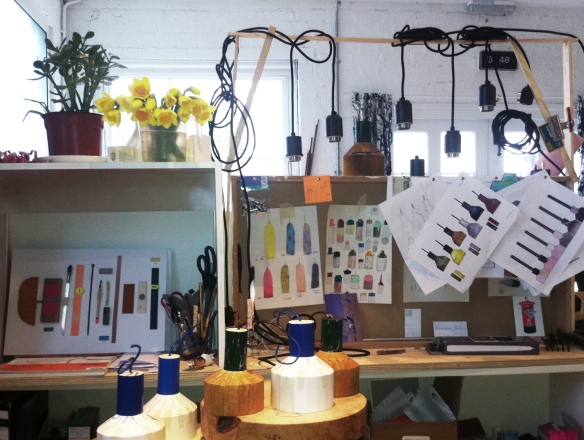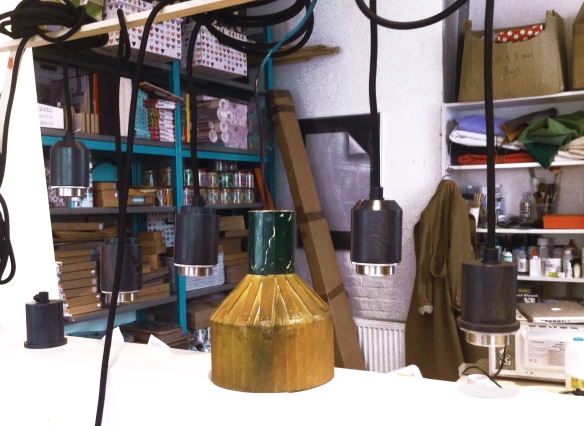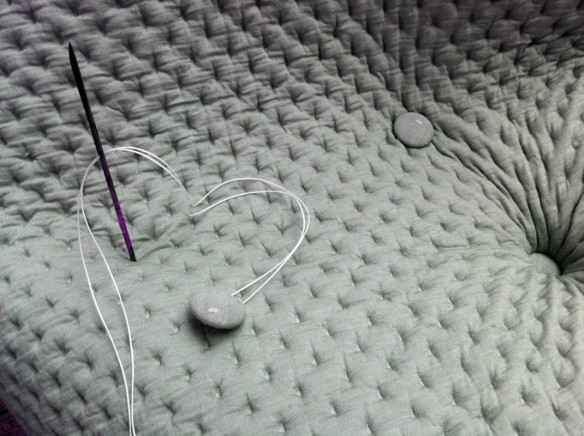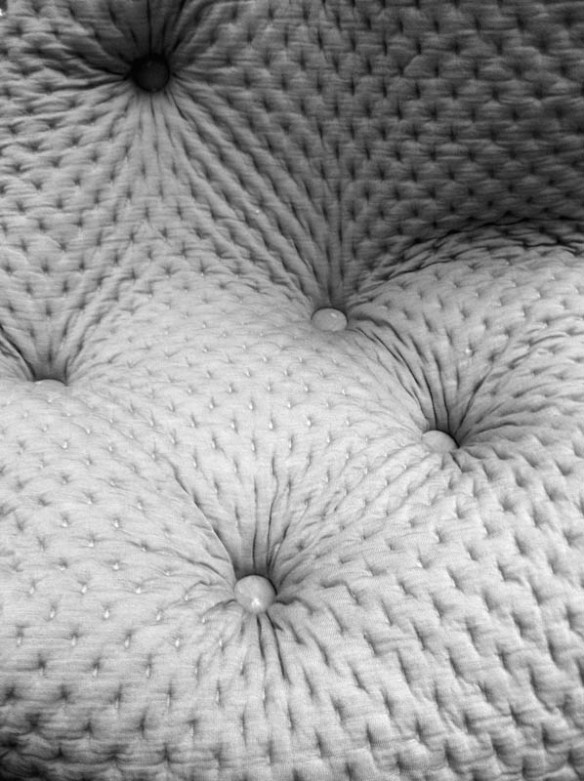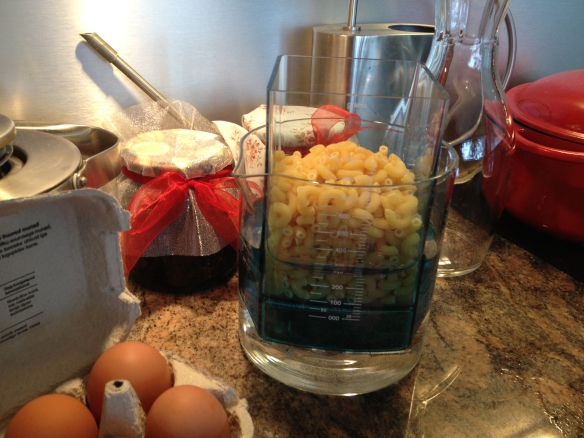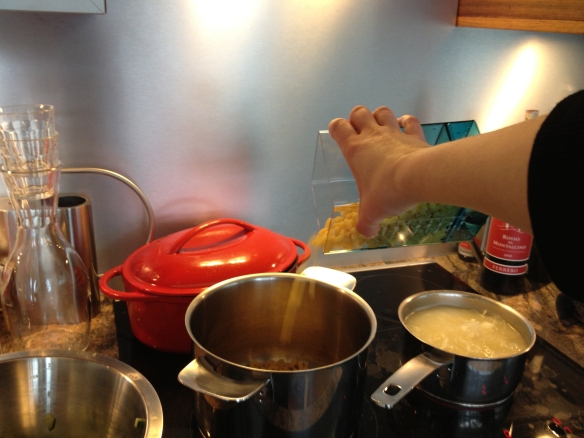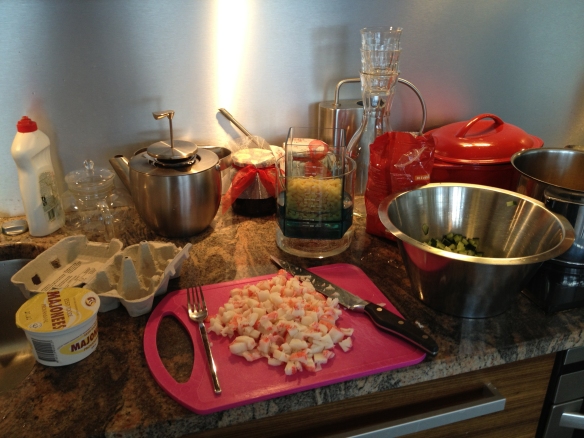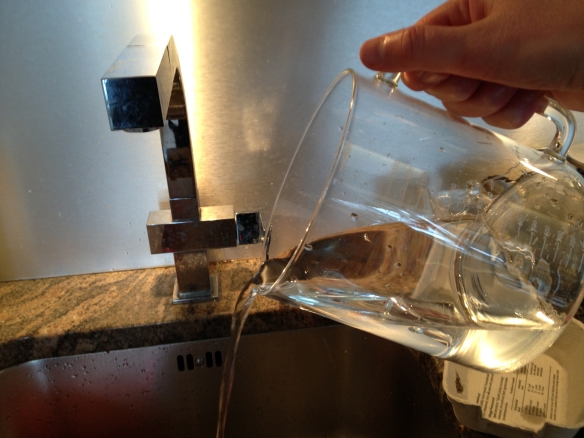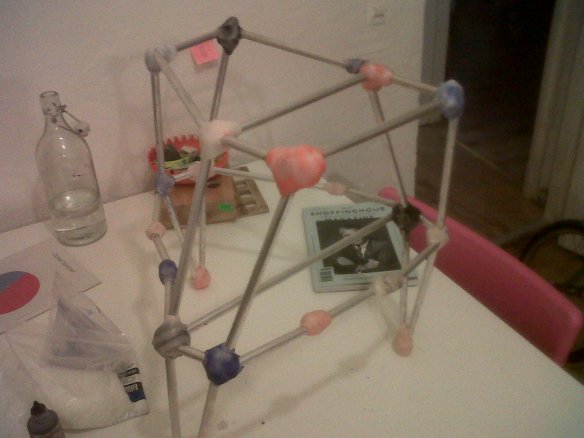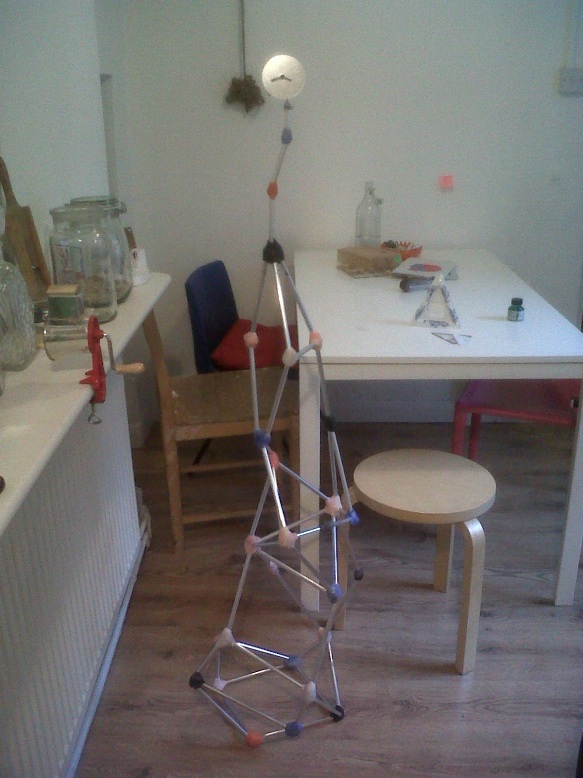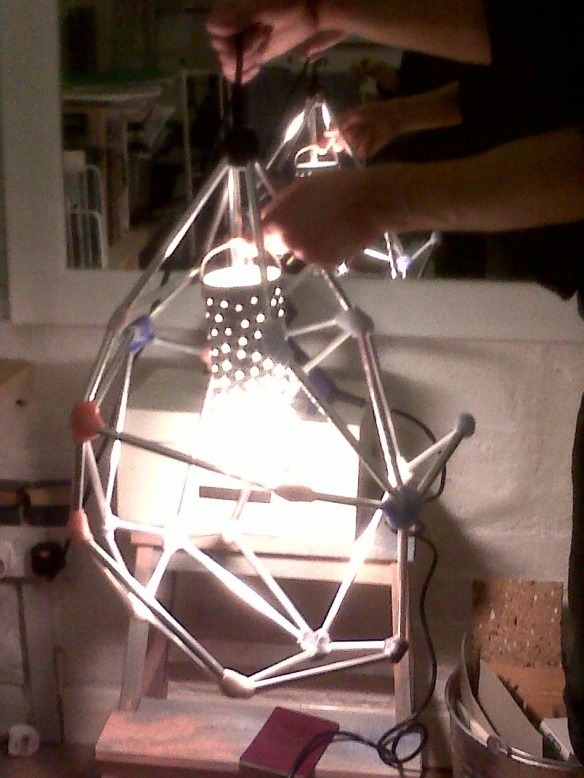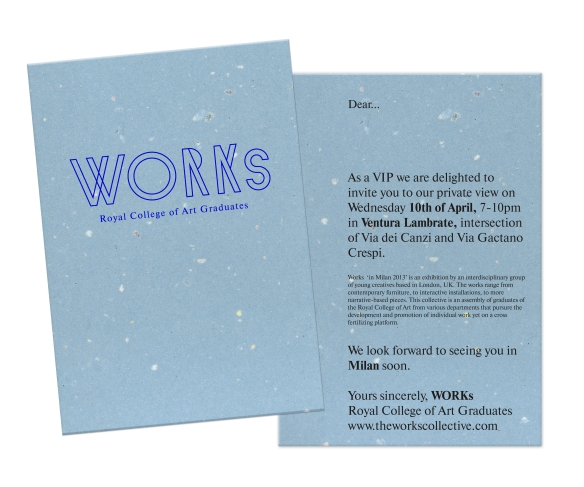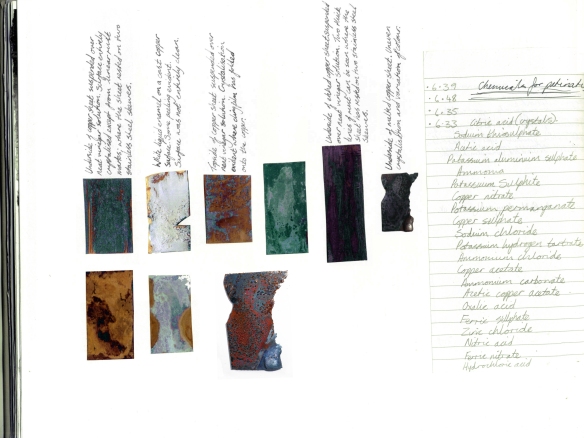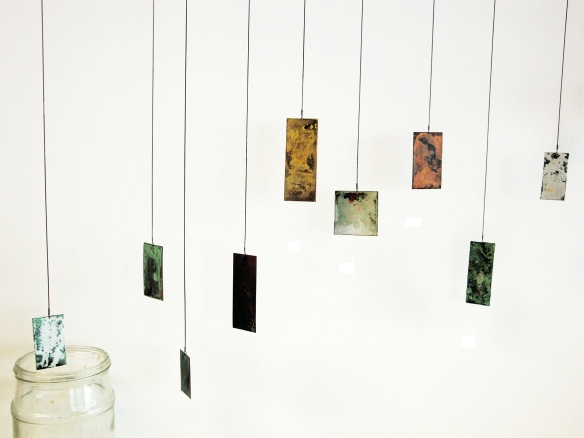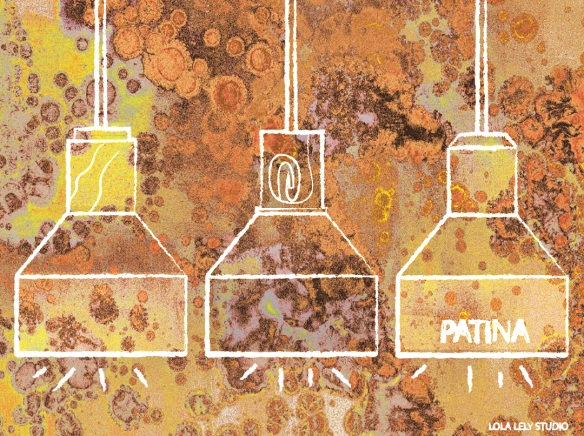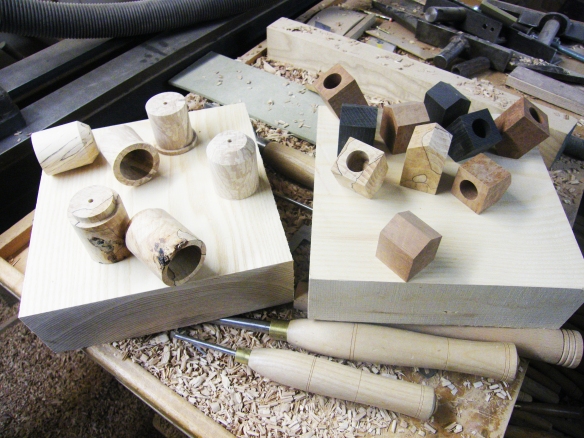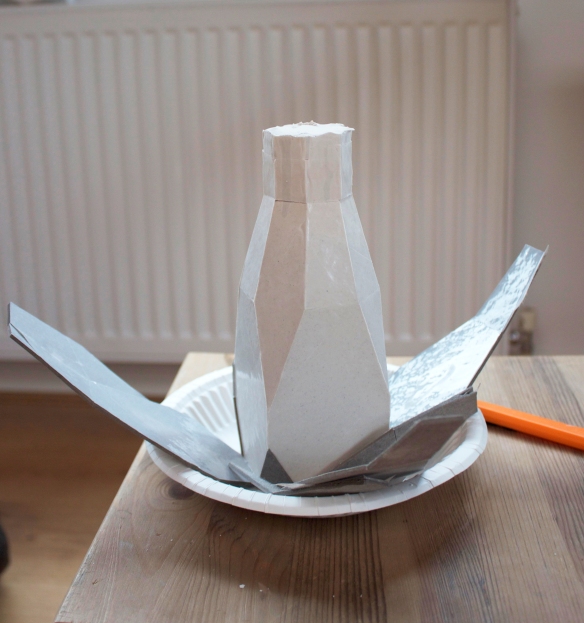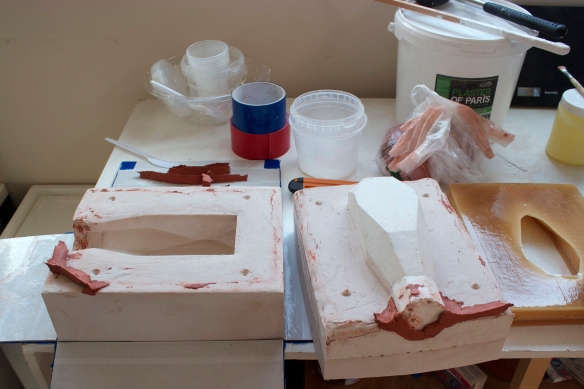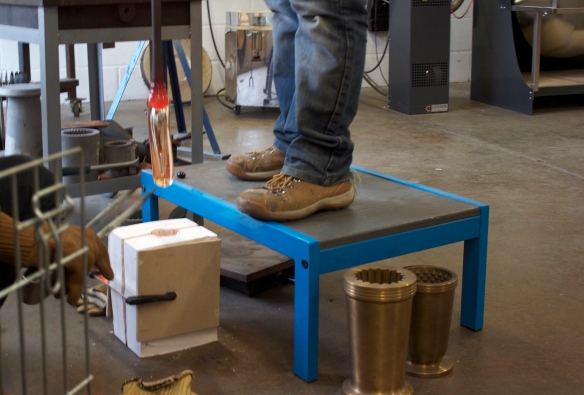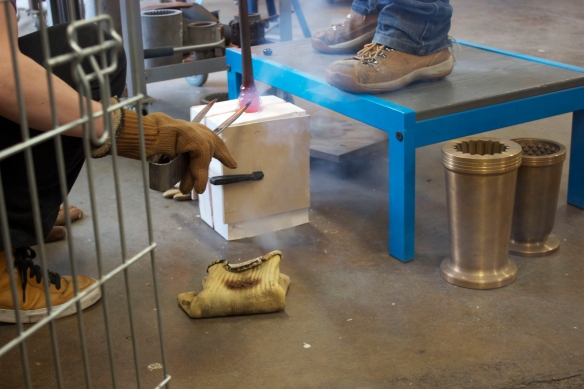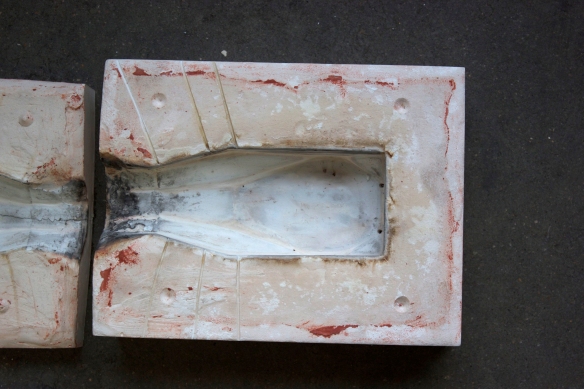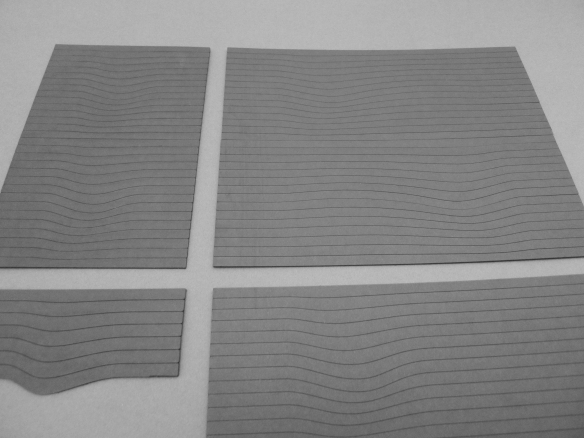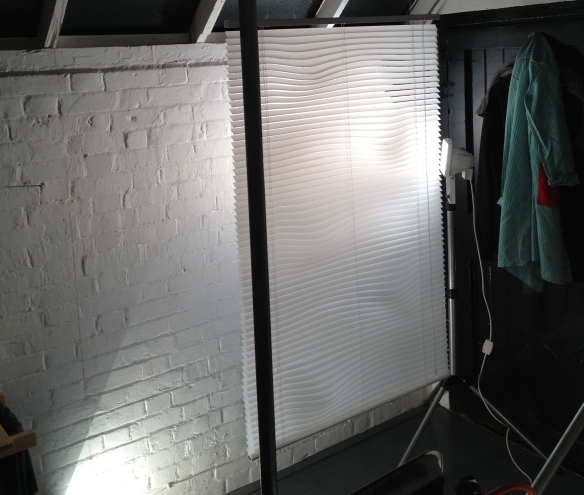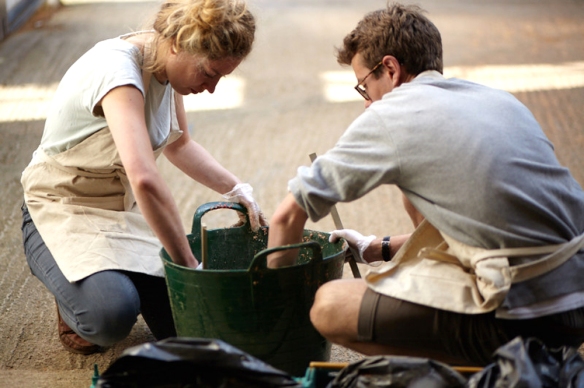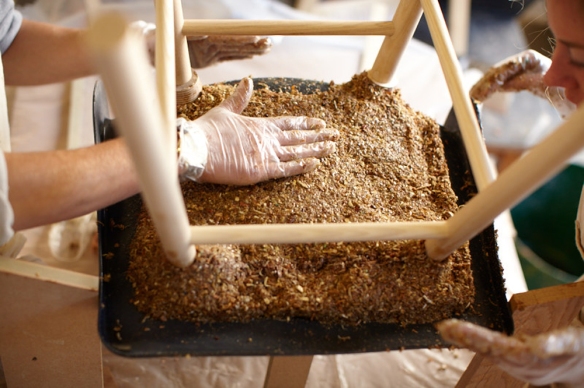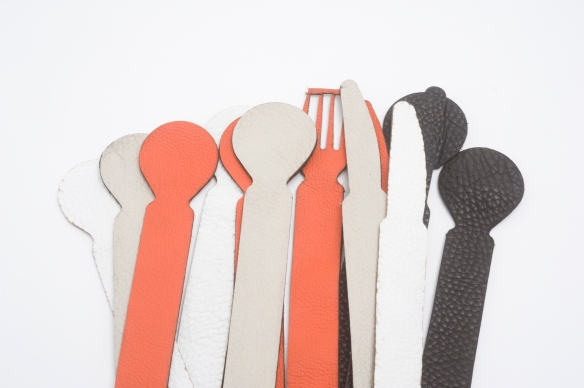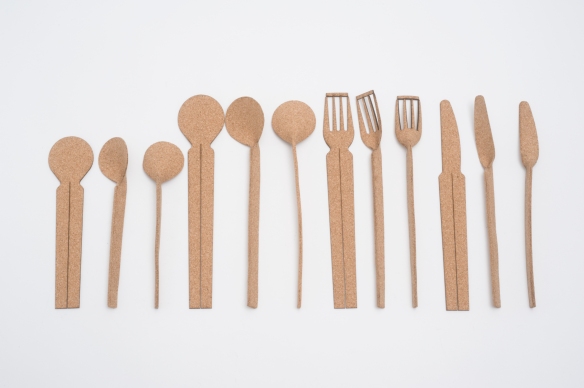Today, we present final process images from our WORKs exhibitors. Take a look at the projects as they come to completion.
FROZEN
 (Fig. 1) Jungin Lee has designed her own textiles with Jimin Seo, Textile designer, in PhD Royal College of Art for the FROZEN seats. The geometric patterned fabric is woven on a jacquard loom.
(Fig. 1) Jungin Lee has designed her own textiles with Jimin Seo, Textile designer, in PhD Royal College of Art for the FROZEN seats. The geometric patterned fabric is woven on a jacquard loom. (Fig. 2) Detail of of the weave structure.
(Fig. 2) Detail of of the weave structure. (Fig. 3) The weaver gives the woven fabric an inspection for irregularities. He tightens where necessary. The weave structure, is also known as the warp and weft.
(Fig. 3) The weaver gives the woven fabric an inspection for irregularities. He tightens where necessary. The weave structure, is also known as the warp and weft. (Fig. 4) Jungin prepares the fabric to fold into the chair structure.
(Fig. 4) Jungin prepares the fabric to fold into the chair structure.  (Fig. 5) The fabric folds into a seat in 15 mins. A resin will be poured into the soft mould and then cured in situ to form the hard inner structure. From the outside, the seat will still retain the softness of the woven fabric.
(Fig. 5) The fabric folds into a seat in 15 mins. A resin will be poured into the soft mould and then cured in situ to form the hard inner structure. From the outside, the seat will still retain the softness of the woven fabric.
PATINA
 (Fig. 1) Lola Lely has been working with master patineur, Derek Bayley from Bronze Age art foundry in Limehouse, East London. Derek is very experienced in the art of patination, and well versed in all of the traditional patinas for bronze sculpture. What makes him different is his willingness to collaborate with designers and to experiment with new techniques and chemical combinations. This collaboration has resulted in some very unusual and striking colour patinas for Lola’s lighting pieces.
(Fig. 1) Lola Lely has been working with master patineur, Derek Bayley from Bronze Age art foundry in Limehouse, East London. Derek is very experienced in the art of patination, and well versed in all of the traditional patinas for bronze sculpture. What makes him different is his willingness to collaborate with designers and to experiment with new techniques and chemical combinations. This collaboration has resulted in some very unusual and striking colour patinas for Lola’s lighting pieces.  (Fig 2.) Once patinated, the bronze lampshades are slightly heated up again and buffed with wax to enhance and seal the patina.
(Fig 2.) Once patinated, the bronze lampshades are slightly heated up again and buffed with wax to enhance and seal the patina.  (Fig 3.) The lampshades are waxed to a lustre finish.
(Fig 3.) The lampshades are waxed to a lustre finish.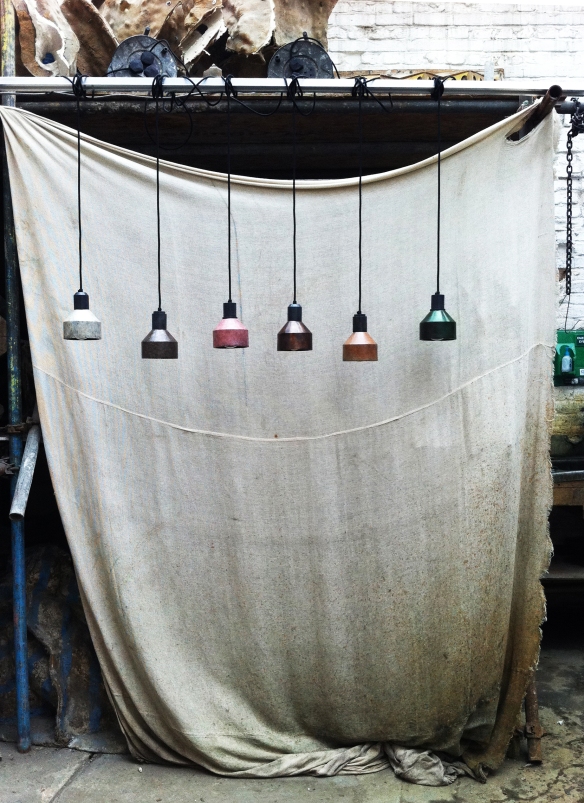 (Fig 4.) PATINA line-up. Each handmade light is unique and one of a kind.
(Fig 4.) PATINA line-up. Each handmade light is unique and one of a kind. (Fig 5.) The PATINA candlesticks have a brighter and bolder patina for a playful feel. These pieces are for the Wallpaper* Handmade exhibition, also showing in Milan 2013.
(Fig 5.) The PATINA candlesticks have a brighter and bolder patina for a playful feel. These pieces are for the Wallpaper* Handmade exhibition, also showing in Milan 2013.
KS_MG
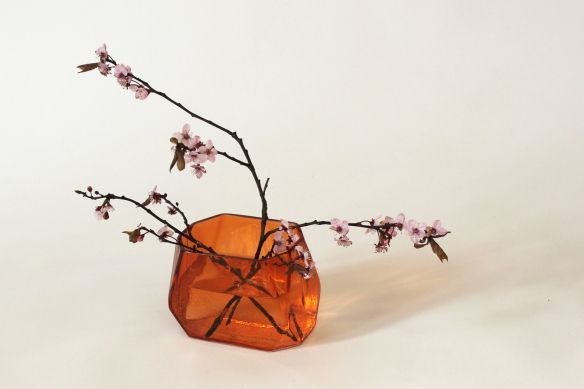
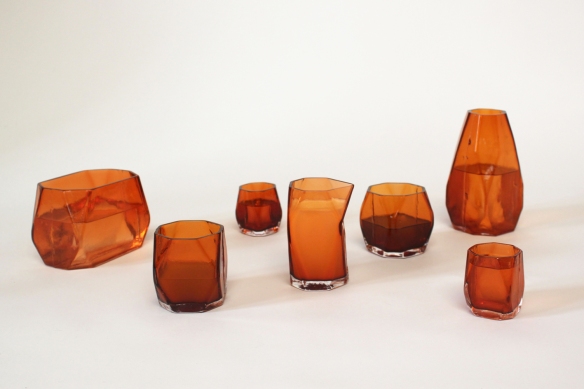

 Meret Probst’s stunning KS_MG glass pieces in amber and translucent is now finished, photographed and ready to be packed for its journey to Milan.
Meret Probst’s stunning KS_MG glass pieces in amber and translucent is now finished, photographed and ready to be packed for its journey to Milan.
WELL PROVEN CHAIR
 (Fig 1.) Made from a mixture of sawdust and bio resin, the Well Proven Chair is left to cure at room temperature.
(Fig 1.) Made from a mixture of sawdust and bio resin, the Well Proven Chair is left to cure at room temperature. (Fig.2) Well Proven Chairs in various colourways – to achieve this pigments were added to the sawdust and resin mixture.
(Fig.2) Well Proven Chairs in various colourways – to achieve this pigments were added to the sawdust and resin mixture.  (Fig. 3) The designers of the Well Proven Chair, Marjan van Aubel and James Shaw were recently nominated for the Design Museum’s ‘DESIGNS OF THE YEAR’ award. The winners will be announced in a couple of weeks. We are really proud of them and want our guys to win!
(Fig. 3) The designers of the Well Proven Chair, Marjan van Aubel and James Shaw were recently nominated for the Design Museum’s ‘DESIGNS OF THE YEAR’ award. The winners will be announced in a couple of weeks. We are really proud of them and want our guys to win!
 (Fig. 4) James and Marjan being interviewed and filmed at the ‘DESIGNS OF THE YEAR’ opening event.
(Fig. 4) James and Marjan being interviewed and filmed at the ‘DESIGNS OF THE YEAR’ opening event.
PACK!
THREAD WRAPPING MACHINE
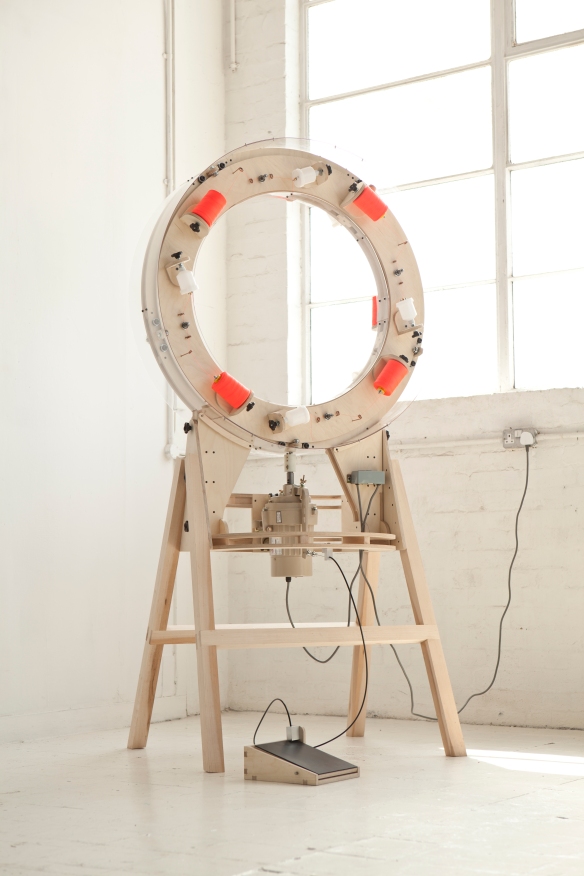 (Fig.1) Anton Alvarez’s Thread Wrapping Machine, is a new technique in joinery. The machine wraps thread around pieces of timber to secure the structure.
(Fig.1) Anton Alvarez’s Thread Wrapping Machine, is a new technique in joinery. The machine wraps thread around pieces of timber to secure the structure.  (Fig. 2) Using different coloured threads adds extra dimension to Anton’s abstract, yet functional pieces.
(Fig. 2) Using different coloured threads adds extra dimension to Anton’s abstract, yet functional pieces. (Fig. 3) Anton will be showing his very tall and wonderfully colourful Thread machine floor lamp at the show.
(Fig. 3) Anton will be showing his very tall and wonderfully colourful Thread machine floor lamp at the show.
75% CONTROL

 (Fig 1. & 2) Dafi Reis Doron’s 75% Control stools are now finished and ready to go to Milan. Dafi has been developing this new type of upholstery foam for the last 2 years. She is there with the technique and we think it will receive a lot of interest at the show.
(Fig 1. & 2) Dafi Reis Doron’s 75% Control stools are now finished and ready to go to Milan. Dafi has been developing this new type of upholstery foam for the last 2 years. She is there with the technique and we think it will receive a lot of interest at the show. (Fig. 3) The foam upholstery creates a very light and flexible structure for furniture construction. Dafi demonstrates how light the stools are by lifting it with one hand!
(Fig. 3) The foam upholstery creates a very light and flexible structure for furniture construction. Dafi demonstrates how light the stools are by lifting it with one hand!
HYBREED
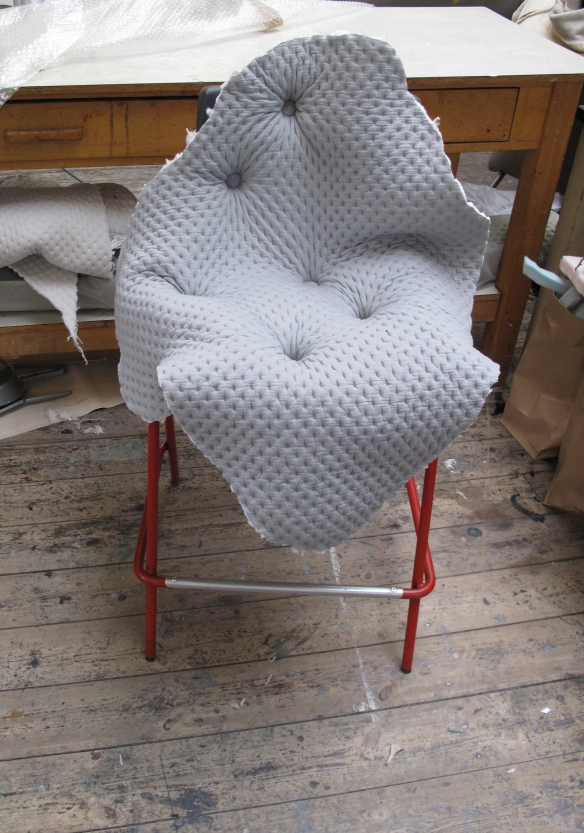 (Fig. 1) Charlotte Kingsnorth is producing two new HYBREED chairs for our WORKs exhibition. The designer has purposefully sourced this much used, old school lab chair as a starting point. With her artistic intent and hand craft approach, the chair will be given new life and transformed into a unique piece of furniture.
(Fig. 1) Charlotte Kingsnorth is producing two new HYBREED chairs for our WORKs exhibition. The designer has purposefully sourced this much used, old school lab chair as a starting point. With her artistic intent and hand craft approach, the chair will be given new life and transformed into a unique piece of furniture. (Fig 2.) A bold green fabric is assigned to the second school chair, with the wooden back and seat.
(Fig 2.) A bold green fabric is assigned to the second school chair, with the wooden back and seat.  (Fig. 3) The two chairs sit side by side – both unique and one of a kind.
(Fig. 3) The two chairs sit side by side – both unique and one of a kind.
LOST LEATHER CUTLERY
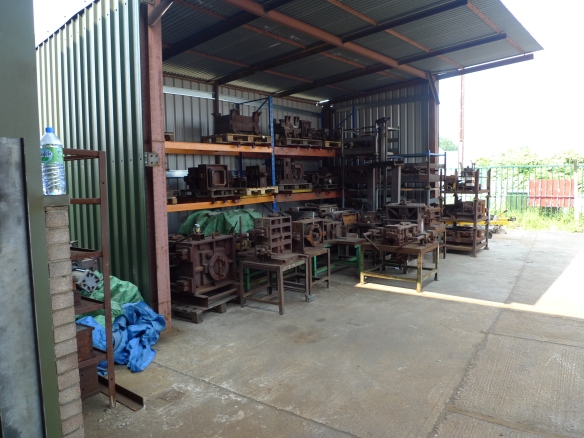 (Fig. 1) Helena Karelson, has spent most of this week at the foundry to cast her leather cutlery.
(Fig. 1) Helena Karelson, has spent most of this week at the foundry to cast her leather cutlery. (Fig 2.) The foundryman attaches wax sprues to the leather investment moulds.
(Fig 2.) The foundryman attaches wax sprues to the leather investment moulds.  (Fig. 3) The moulds are then dipped in slurry a couple of times.
(Fig. 3) The moulds are then dipped in slurry a couple of times. 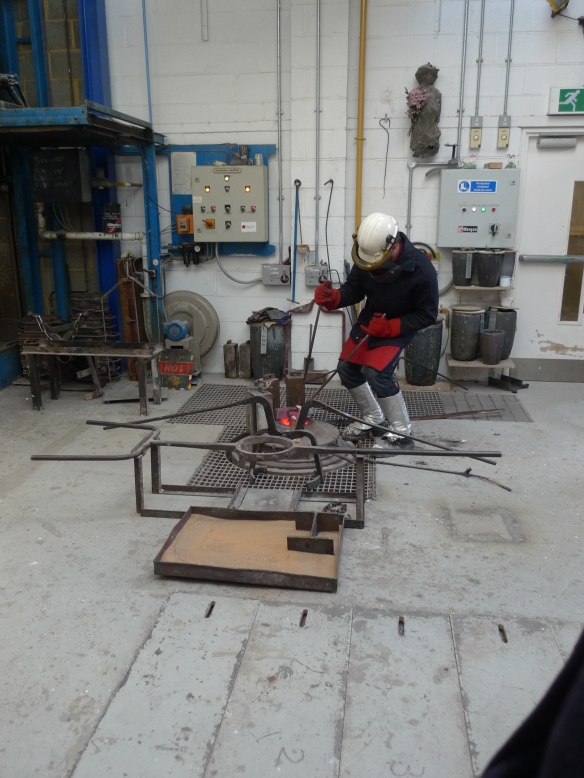
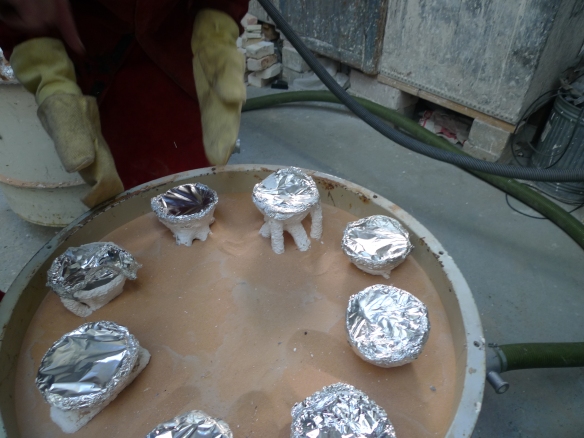 (Fig. 4) The moulds are now ready for casting in 6 minutes. Casting sand covers the mould and then molten aluminium metal is poured into the cavities.
(Fig. 4) The moulds are now ready for casting in 6 minutes. Casting sand covers the mould and then molten aluminium metal is poured into the cavities. (Fig. 5) When the investment mould is burnt out, the aluminium cast cutlery is tumbled in the pan to remove some of the excess shell.
(Fig. 5) When the investment mould is burnt out, the aluminium cast cutlery is tumbled in the pan to remove some of the excess shell.  (Fig 6.) A close-up of the final cast pieces.
(Fig 6.) A close-up of the final cast pieces.
BONELAMP
 (Fig. 1) Eirik Helgesen has designed the Bone Lamp from aluminium rod produced at the controversial Alcoa aluminium factory in East Iceland, merged with bones from wild reindeer of the same area. Combining these materials into one object is part of a grater investigation looking at the encountering between global industry and local culture.
(Fig. 1) Eirik Helgesen has designed the Bone Lamp from aluminium rod produced at the controversial Alcoa aluminium factory in East Iceland, merged with bones from wild reindeer of the same area. Combining these materials into one object is part of a grater investigation looking at the encountering between global industry and local culture.
Pictures above displays his two main collaborators while developing the lamp: Alcoa worker Oskar Bjørnsson and reindeer-craftsman Þórhallur Árnason. Both were providing essential material and knowledge for the project. (Fig. 2) The reindeer legs and its hooves are boiled 4 to 6 hours to be workable. (The boiling is done outdoor, as the smell is unbearable).
(Fig. 2) The reindeer legs and its hooves are boiled 4 to 6 hours to be workable. (The boiling is done outdoor, as the smell is unbearable).  (Fig. 3) Bone after boiling and cleaning.
(Fig. 3) Bone after boiling and cleaning. (Fig. 4) Experiments with aluminium to form the lamps structure and clamp function.
(Fig. 4) Experiments with aluminium to form the lamps structure and clamp function.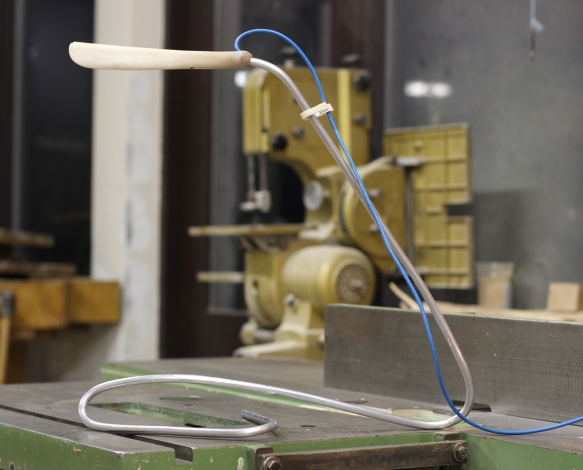 (Fig. 5) The lamp in upraised position showing the final principle for the structure.
(Fig. 5) The lamp in upraised position showing the final principle for the structure. (Fig. 6) Test of structure in collapsed position.
(Fig. 6) Test of structure in collapsed position. (Fig. 7) Final shape of the “lampshade” in profile, and from the underside with LED lights.
(Fig. 7) Final shape of the “lampshade” in profile, and from the underside with LED lights.

